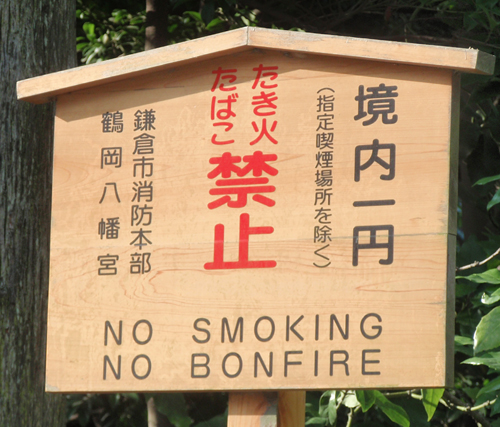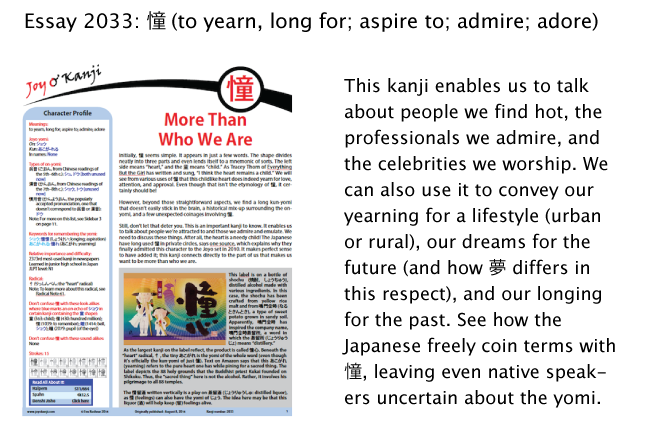Rounding Out the Picture
If I lived in ancient times and if someone asked me to create a pictograph, I probably would have been lazy and chosen to make one for "circle" or "round." And I would have designed it just like this: ○. Done!
But that wouldn't have been allowed, or at least the design would have changed over the years. For reasons that escape me, current versions of Chinese characters contain no round parts. Thus, we're left with 円 as the absurd representation of "roundness." Actually, the shape used to be 圓, which is even more rectilinear. Henshall says with no apparent irony that the "enclosure" radical 口 means "roundness" here and that the equally sharp-edged 員 inside means "round kettle," also acting phonetically to express "circle." He says, too, that the associated meaning of "coin" in China ("yen" in Japan) comes from an association with all this roundness.
By the way, here's an ancient image of 円 from Richard Sears's etymology page. To me it looks like a cartoonish frowning face!

Etymology is just the beginning of the surprises that 円 (エン, まる•い) offers.
Take, for instance, this sign from Kamakura:

Photo Credit: Eve Kushner
I initially mistook 一円 for "1 yen." Of course I did! That's the most instinctive way to read this word. I wonder if I'll ever reach the point where I can glance at the black kanji on the right and interpret them properly, which would be this way:
境内 (けいだい: grounds (esp. of a shrine or temple))
一円 (いちえん: throughout (an area))
Because 円 can mean "rounded out," it also means "whole" and "complete," and I can only imagine that that's what it contributes to this kind of 一円.
This word has the same meaning in the following sentence:
関東一円に亘って被害が出た。
It caused damage across wide areas of the Kanto region.
関東 (かんとう: eastern Honshu, including Tokyo); 亘る (わたる: to cover certain areas); 被害 (ひがい: damage); 出る (でる: to cause)
The keyword provides full coverage within a certain limit. That is, if we imagine an enclosure, 一円 represents the whole area inside it. And 亘る (written with a non-Joyo kanji) reiterates that sense of all-inclusiveness.
In the next photo, 円 plays one of its usual roles, representing currency:

Photo Credit: Eve Kushner
It's hard to focus on kanji when someone has made you think about green tea ice cream (my favorite Japanese food!). But just accept that you're not getting any of this ice cream and enjoy the fat-free, lactose-free kanji instead!
Here's what the sign says:
抹茶* (まっちゃ: matcha; powdered green tea)
宇治 (うじ: uji (tea)), which is produced in Uji, just outside of Kyoto
使用 (しよう: use)
So far, we know that the ice cream is made of uji tea, which happens to be one of my favorite types of green tea. Sigh.
On the bottom line we find these words:
旨味 (うまみ: deliciousness)
苦味 (にがみ: bitter taste)
I'm surprised to see 旨味, as that word is all the rage right now in California restaurants and is even the name of a burger chain. I wonder how many people around here really know what it means. I certainly don't. There's all this talk about a fifth flavor, which comes off sounding as ethereal as a sixth sense or a third eye. Umami Burger's definition of "umami" includes this phrase: "It is amplified by the vibe of the room, the energy of the community." Oh, dear. Oh, dear.
Apparently, "umami" is effective marketing jargon. It sounds cool and exotic to have "umami" roll off the tongue and to act as if you have some keen awareness of another dimension. However, I think this down-to-earth ice cream shop on Sado Island only meant "deliciousness."
But what's this about bitterness? That seems like an odd selling point. Then again, matcha is undeniably bitter, and I suppose people who order matcha ice cream are game.
With all these distractions, I've skipped over the point I wanted to make about 円. I also skipped over the hiragana. In this case, まろやか corresponds to the following word:
円やか (まろやか: round; circular; spherical; mild (taste))
I wonder how 円 came to be associated with a word for "mild (taste)." Maybe it's the opposite of a sharp taste, which I never associate with acute angles or anything, but if you did think that way, it would certainly explain the connection between 円 and mildness!
To my surprise, my proofreader agrees with this approach, noting that 円 can mean "having no corners or edges." From there it's not a big leap to “mild.” He says that the Japanese use these ideas to describe personalities; 円やか means “soft,” “mild,” mellow,” or “mature," as in this example:
社会に揉まれて、彼は円やかになった。
Interacting with other people has made him mellow.
社会 (しゃかい: society, people); 揉む (もむ: to rub, shown here in the -て form of its passive voice); 彼 (かれ: he)
This literally means "Mixing with other people has smoothed down his rough edges." By the way, 揉 is non-Joyo.
Wikipedia says that umami rounds out the overall flavor of a dish, so there's actually a connection between 円 and 旨味, one that the ice cream store probably never intended.
I wish the sign maker had used 円やか rather than hiragana. If they had positioned 円 at the start of the bottom line, we could have seen back-to-back instances of the same kanji. And those 円s would have appeared with different yomi and unrelated meanings. Seeing that would have been nearly as scrumptious as the cool matcha cone that hit the spot on that blisteringly hot afternoon.
On that day in particular, I yearned for green tea ice cream. Now that I've written the newest essay, I know how to say that in Japanese! Here's a preview:

Have a great weekend! I hope it has a certain umami to it, if I can use that abstractly and pretentiously to mean "a certain je ne sais quoi"!

Comments